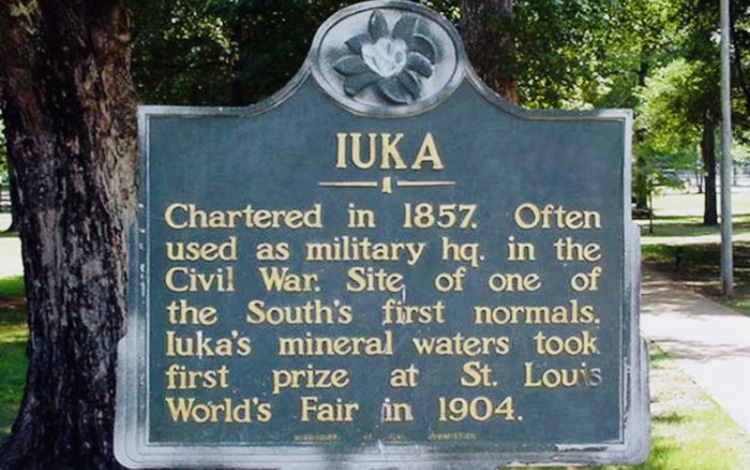Historic Mineral Springs Park in Iuka has a history of healing…from its waters.
In the early 1800s, Chief Iuka of the Chickasaw had been suffering from chronic ailments for many years, his tribal healers unable to help him, when he heard of the magical healing waters. Carried by his followers to the springs, the chief drank the waters and quickly regained his health. He moved his family to the area and never left. His experience was well-known to people up and down the valley.

By 1840, there was a substantial settlement of pioneers who followed the lead of Chief Iuka, and a town was born. The Memphis and Charleston Railroads came through the area in 1856. This movement was highly influenced by the popularity of Mineral Springs Park.
Unfortunately, this also made Iuka a target for Union armies during the Civil War, and three significant battles were fought. Both armies camped in the Mineral Springs area at different times, and the story of Mineral Springs began to spread far and wide.
After the Civil War, the Mineral Springs became a popular retreat from the ravages of Yellow Fever. Visitors flocked to the park from all over the country, and eventually, pavilions were built over the springs so visitors could comfortably access the water. A grand hotel was even built. Trains arrived from New York and Washington with loads of tourists who enjoyed the era’s big bands and the evening strolls through the park.
In 1904, the World’s Fair in St. Louis awarded the Mineral Springs Park first prize among all entrants of mineral water. Grand plans to bottle water from Mineral Springs began, but World War I started and plans changed.
The hotel burned, and the park gradually decayed from neglect, even to the point where the springs failed to flow because of the buildup of mineral deposits. There was no bottled water, big band concerts, trains from Washington, and very little enthusiasm for the “healing waters” anymore. World War I ended everything.
The Iuka Lions Club helped restore the park in the 1970s. Matching grants from federal and state programs helped bring the park back to life. Playground equipment, benches, a bandstand, and other improvements were added.
The water has been tested, and it determined that each spring possesses different healing abilities, treating everything from anemia to stomach viruses. The springs also underwent maintenance to restore them as much as possible to return functionality. As of today, three of the six springs are still flowing.
The following analysis was pulled from facts s provided by the Iuka Public Library and the Tishomingo County Archives and History Museum.
Here is the study of the waters of the healing Mineral Springs of Iuka.
Spring No. 1
For chronic malarial chills, loss of appetite, anemia, and general debility. Analysis: largely Peroxide of Iron, small quantities of Aluminum, Chloride of Lime, Chloride of Potassium, Chloride of Sodium, Free Carbonic Acid, and Sulphates in small proportions.
Spring No. 2 – The Beauty Spring
For dyspepsia (indigestion) and stomach troubles of all kinds. Analysis: largely Sulphurated Hydrogen, Free Carbonic Acid, with a small amount of Bicarbonate of Magnesia, Bicarbonate of Lime, Bicarbonate of Potash and Soda, and Chlorides of Potassium and Sodium.
Spring No. 3 – The Star Spring
For nervousness and as a general tonic. Analysis: Bicarbonate of Iron, Free Carbonic Acid, with a small amount of Bicarbonate of Magnesium, Bicarbonate of Potash, Bicarbonate of Soda, and traces of Chloride.
Spring No. 4 – Alum Water
For sore eyes, ulcers, inflammations, and sores of rheumatish. Analysis: Protosulphate of Iron, Sulphate of Soda, Carbonate of Magnesia, Chloride of Calcium, Sulphate of Aluminum, Earthy Phosphates, and Iodine combined with Magnesium.
Spring No. 5 – Black Sulphur Water
For Bright’s disease and all affections of the kidneys, bladder, and stomach. Analysis: Protoxide of Iron, Chloride of Sodium, Chloride of Calcium, Sulphate of Lime, Sulphate of Magnesia, Sulphate of Soda, Sulphurated Hydrogen Gas, and Carbonic Gas.
Spring No. 6
Analysis: Iron, Calcium, Magnesium, Bicarbonates, Silica, Sulphate of Radicle, Sodium of Potassium, and Chloride.
Chief Iuka’s grave is nearby, supposedly part of the foundation of the BancorpSouth (Cadence) building in Iuka. The chief chose this place to live out his life. Now, he has become a solid part of the locale, embedded in the physical and the historical elements and forever associated with the healing waters of Iuka’s Mineral Springs.